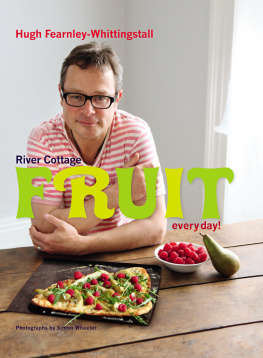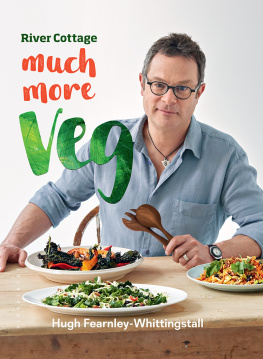
Introduction
Beautiful, bountiful and bouncy, fruit is a truly fantastic food. Its so delicious and so very, very good for us and yet it remains ridiculously under-explored in our kitchens. We are, frankly, a nation that still thinks its a bit racy to slice a banana on to our breakfast cereal. I want to change that. I think its time to revolutionise the way we eat fruit. A piece of fruit in a lunchbox or at the end of a meal is all very well but there is so much more we could be doing with fruit, and Im impatient to get that ball rolling for you.
In part this will mean taking a leaf (or a fruit) from foreign food cultures, for whom including fruits in cooking is often second nature, in savoury recipes as well as sweet: think of the tagines of North Africa where dates, apricots and preserved lemons mingle with tender spiced meats; think of the tart, aromatic flesh of mangoes, papayas and pomegranates in Far Eastern salads and salsas; and we shouldnt overlook sour cherries and tart berries in the soups and stews of Scandinavia and Eastern Europe either. Why should we let these culinary competitors steal a march on us? Do we really think roast pork with apple sauce, fine as it is, is a strong enough entry in the international fruit-in-a-savoury-recipe cookery Olympiad? What about our pears, plums, berries and currants? Dont they deserve a look-in too?
Before we get stuck into the recipes, though, lets remind ourselves why fruits are so special. They are the only foods that want to be eaten. To fulfil their evolutionary mission in a competitive world (its a fruit jungle out there) they have fashioned themselves into pretty much the perfect foodstuff visually irresistible, cleverly packaged, nutritious and, most importantly, delicious. Their consumption is an integral part of their life cycle. We eat a piece of fruit, we spread the seed, the seed grows, the plant fruits. Along with many of our fellow mammals, birds too of course, and other species, fruits have systematically seduced us.
Down the centuries, fruits have had us working on their behalf, nurturing and cultivating them to make them even plumper, juicier and sweeter. Most varieties can now be eaten as soon as theyre picked, plucked or cut raspberries off the cane, cherries off the tree, currants off the bush. And even if you dont grow any yourself, fruit is always accessible: in greengrocers and supermarkets of course, but also on the street. Fruit has beguiled us so much, and we are so proud of our success in growing it, that we cant resist piling it into vast colourful displays of conspicuous delight. Now, in major cities all over the world, fruit stalls come out to greet us on the pavements, to dazzle us with sheer temptation.
And yet I reckon that many of us could do with a fruit boost. I think we know in our hearts that unless we are eating fruit every day, were probably not eating enough. So why is it that, for so many of us, fruit isnt quite happening? One reason is that we dont always fully understand fruit when its in season, how to buy it at its best, what to do with it. Or we take it for granted. The fruit bowl becomes a decorative item, and a symbol of good intentions. If we dont want to munch that apple right now, well leave it till tomorrow. Tomorrow comes and, surprise, surprise it isnt looking any more tempting
I intend to address any such lingering fruit apathy head on, with advice on sourcing, storing, ripening, cooking and eating this amazing resource. Youll find recipes for almost all the seasonal fruit that grows in this country, from the first forced pink rhubarb of January, through juicy early summer berries and high summer plums and gages, to the bounty of our autumn apple and pear harvest and by no means neglecting the blackberries, damsons, hips and haws that are the seasons rich hedgerow pickings. But I dont stop there. Im all for enjoying fruits from other parts of the world, especially when our own are out of season. Imported fruits are mainly shipped, not flown, so the environmental burden is not so great as with many veg. They are also the agricultural staples of communities that rely on our support. Fairtrade and organic labels flag up the most responsible and sustainable options. So oranges, lemons, limes and clementines, Mediterranean figs, grapes and melons, as well as tropical favourites like bananas, pineapples and mangoes, are all included in my fruit extravaganza.
I hope to refresh your view of all these fruits, and more, and help you put them slap-bang at the centre of your everyday eating, where they belong. So as well as offering my personal versions of fruity classics that we already know and love the pies, crumbles and cobblers, the ice creams and sorbets, the simple combinations of fruit with cream, custard or meringue Ill encourage you to start cooking with fruit in some new ways. I want you to put all kinds of raw fruit in your savoury salads, and some savoury things, herbs for example, in your sweet fruit salads. I want to persuade you to put fruit on a pizza (not ham and pineapple, I promise) and into your daily bread. I want you to introduce it to your rich and meaty stews and pies. I want to show you how surprisingly well fruit goes with fish, both hot and cold.
And so drum roll I bring you strawberry panzanella; kiwi and apple with tarragon; rocket, pear and raspberry pizza; broad beans, blueberries and bacon; slow-roast lamb shoulder with spiced apricot sauce; chicken, leek and plum pie; banana kedgeree; rhubarb fish parcels with soy and ginger; oysters with apple and shallot vinegar Well over half my recipes are savoury dishes that Im sure you wont have tasted before, the rest are sweet treats and puds selected for their sheer fruity intensity. Im convinced youll find these recipes inspiring, intriguing and refreshing. They might just change the way you cook forever!


Punching juicily above their diminutive weight, berries and currants are luscious, generous fruits, rich in vitamins and antioxidants. They are perhaps the most instant fix of summer to be found in a food thats real sunshine stored in their ripe, sweet juices! Wonderful as they are to cook with, theyre best of all neat or nearly neat. A bowlful of Scottish raspberries, or homegrown alpine strawberries, with nothing more than a shake of sugar and a slosh of cream, is hard to beat. So much so, that we very rarely try
But thats certainly not the only way to celebrate our best summer soft fruits. They are far more versatile than you may ever have given them credit for. Savoury outings open up a whole new summer vista: , I think you might be converted before I even get to the end of the sentence.
Bursting as they are with new possibilities, we have to face a hard fact about berries and currants: shop-bought specimens are often awfully disappointing. Why is it so easy to find insipid strawberries and blueberries, and too-tart raspberries? And why is it so hard to find redcurrants and gooseberries at all? The answer is that the modern marketplace has turned some of these fruits particularly strawberries and blueberries from seasonal treats into year-round staples, with under-ripe and underwhelming imported fruit standing in for the real homegrown deal for eight or nine months of the year.
Meanwhile other classics, such as gooseberries, redcurrants and blackcurrants, are almost entirely neglected when we could be feasting on them from July to September. Did you know that over 95 per cent of all the blackcurrants grown in the UK are used to make a certain well-known blackcurrant drink? Ive nothing against this cordial in fact I think its great that this household brand continues to use British fruit but surely we could stake a claim on some of this luscious fruit for our own kitchen forays (if only to make a very grown-up version of that cordial see for my delicious homemade cassis).
Next page




















